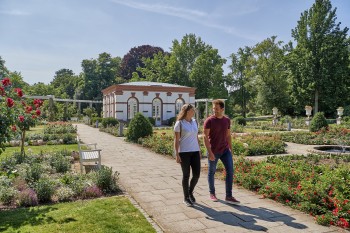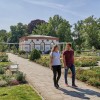Contents
Description

The Palm Garden is one of the largest urban green spaces in Frankfurt, alongside the Botanical Garden and the Grüneburgpark. As an exotic oasis in the heart of the city, the Palm Garden offers a diverse range of tropical plants.
Covering an area of 22 hectares, the garden features greenhouses totalling 7,000 square meters, allowing it to house a plant collection from all climate zones of the Earth. A special highlight is the over 200-year-old palm trees that not only form the backdrop of the Palm Garden but also enhance its tropical atmosphere.
The park is thematically divided into different plant climate zones. These include the Tropicarium, showcasing the dry and humid tropics, as well as the cactus and fuchsia garden, the boat pond, the rose garden, and the octagon fountain, which define the landscape during the summer months. The steppe, perennial, heath, and rock gardens, along with the rhododendron garden, are also worth a visit. The Aripuca Garden and the flower bed impress with their unique design and the colourful array of plants. The flower and butterfly houses, home to Monarch, Banana, and Morpho butterflies, are also a sight to behold.
For relaxation and leisure, there are lawns for lying down, and for younger visitors, there are playgrounds to enjoy. Besides its diverse plant life, the Palm Garden also hosts cultural institutions like the Papageno Theatre, the House Rosenbrunn, Villa Leonhardi, and an art gallery. On-site facilities include restrooms, cafés, and a restaurant. Additionally, the Gesellschaftshaus regularly hosts events and festivities.
Historical Information
The Palm Garden in Frankfurt was first opened in 1871 and was established by a society that eventually evolved into the Palm Garden Society. The society acquired the tropical construction and plant stocks of the Orangerie belonging to Duke Adolf of Nassau, making the plant collection accessible to the public for the first time.
In the 1890s, the Palm Garden was expanded to include an ice rink, which was converted into a tennis court in the summer. It quickly became a popular meeting place for the upper class. During World War I, the Palm Garden faced financial difficulties and eventually transitioned from a joint-stock company to the ownership of the city of Frankfurt. During World War II, the Palm Garden was not spared and suffered significant damage. Restoration efforts continued until 1954.
After restoration, a 650-meter-long park railway was opened in 1972, leading visitors through the Palm Garden until 2021. The Gesellschaftshaus, dating back to the early years of the Palm Garden, underwent extensive renovation between 2002 and 2012, with a total investment of 40 million euros. Today, the renovated Gesellschaftshaus houses a high-quality two-star restaurant. In 2018, construction began on a new butterfly house and a new flower house, which were ultimately inaugurated in 2021 for the 150th anniversary of the Palm Garden.
Interesting facts
- The day pass at Palm Garden Frankfurt is €9 making it one of the 3 cheapest tourist Attractions in Hesse.
How to get there
The Palm Garden is located in Frankfurt's city centre.
- The easiest way to reach the garden is by public transport.
- The nearest subway station is "Bockenheimer Warte," and you can take a bus to Palmengartenstraße.
- If you're travelling by car, you can use the Palmengarten parking garage.



